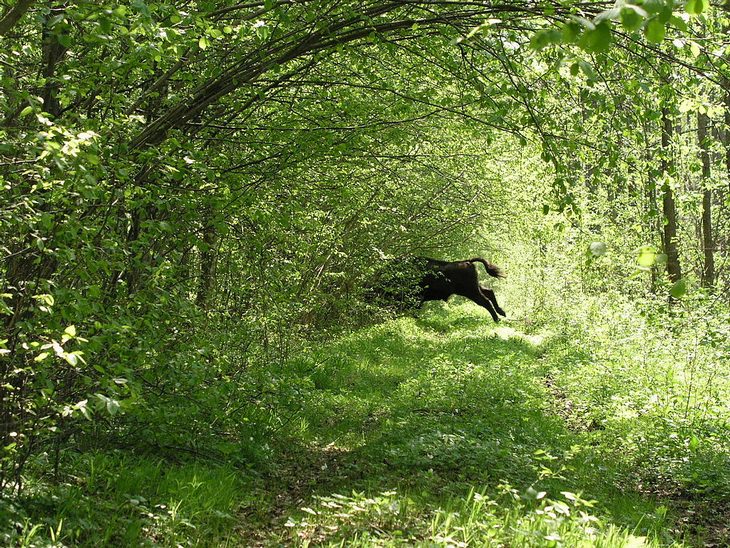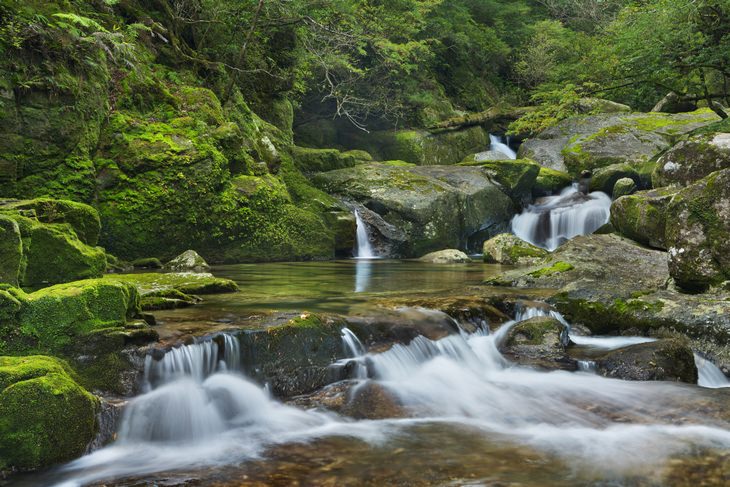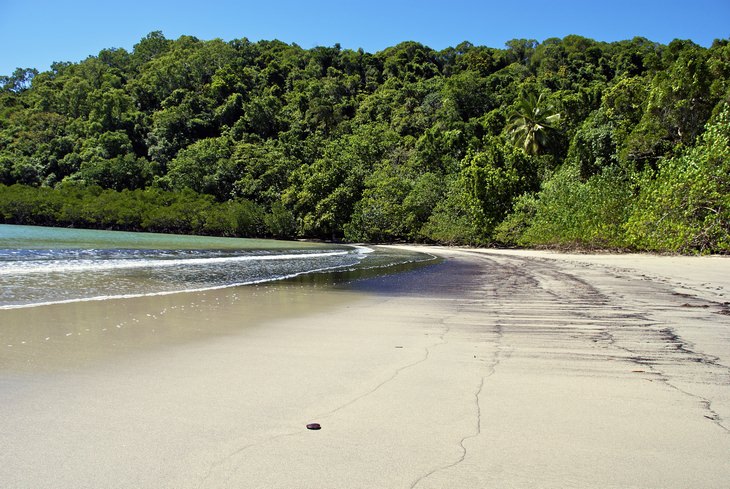

Age: 450 years
Size: 580 sq. miles
Despite being one of the smallest forests on the list, Bialoweiza spans over the border of Poland and Belarus. This forest is a living piece of history, being the last surviving fragment of the primeval jungle Europe once was. In the Middle Ages, it served as hunting grounds for kings and tsars.
Prominent Sights
Wolves, lynx, red deer, wild boar, elk (same as moose in North America), and roe deer are among the inhabitants of this forest. However, the most remarkable resident of Bialoweiza is the European bison. This breed was practically extinct by the beginning of the 20th century. In 1927, there were only 50 bison left, all held by zoos. A special breeding project was set up in the forest in order to release the captive animals and reintroduce them to the wild. Today, there a roughly 900 bison roaming freely in the Bialoweiza forest.
Visiting Bielowiza
You could visit the forest from either the Polish side or the one in Belarus. The Polish town of Białowieża is located right at the edge of the reserve, and it is easily accessible by car, train, or bus from Warsaw. The administration on the Belarusian side is based in Kamenuicky.
Once you’re there, renting a bike would be a good way to enjoy the beauty of the forest, as it has extensive bike trails. There are also bison watching tours, of course, as well as a wildlife museum and a folklife and old technologies museum. If you’re visiting with children, the Santa Claus residence is open all year round and is actually one of the most visited tourist sights in Belarus.
Related Article: The Most Beautiful Trees and Forests

Age: Approx. 5000 years
Size: 43.75 sq. miles
Ancient Bristlecone Pine Forest is located in the White Mountains in Inyo County in eastern California. Bristlecone pines are known for their unique, sculpture-like shape. What’s fascinating about these trees is that they thrive in one of North America’s most inhospitable environments, 10,000 feet in elevation on some of California’s tallest mountains.
Prominent Sights
The forest is home to Metushelah, the confirmed oldest tree in the world. its astounding age is 4,851 years. Just to give you a perspective on how long that is, this tree was around at the time when writing started developing in Egypt and triggered the beginning of recorded history. Unfortunately, the exact location of Metushelah is not marked in the forest to protect it from vandals.
In the Patriarch Grove, however, you can easily find the Patriarch Tree, the world’s largest bristlecone Pine. This huge tree has a 39-foot diameter and is definitely an impressive sight. A visit to the groves will allow you to enjoy a magnificent view, with the Sierra Nevada to the west; just remember to bring lots of water.
Visit Ancient Bristlecone Pine Forest
As mentioned above, the forest is made up of two groves, Shulman Grove and Patriarch Grove. It is possible to visit them both on the same day if you get an early start, as visiting hours are from 10 am to 6 pm. Camping is not allowed in the bristlecone forest itself. The closest town to stay in is Big Pine, but there is a wider choice of places around Mammoth Lake, which is about a 2-hour drive from the forest.

Age: approx. 7000 years
Size: 4.7 sq. miles
This fairytale-like cedar forest is found on Yakushima island, 37 miles south of Kyushu, Japan’s 3rd largest island. The forest covers most of the island and walking through it feels like being a world away from the hustle and bustle of Japan’s urban areas.
The Japanese cedars are called Yakusugi (a combination of Yakushima and sugi, the Japanese word for cedar), and their age ranges from 1,000 to 7,000 years. The moss-covered twisted roots and the moody atmosphere of Yakushima were the inspiration for Studio Ghibli’s famous animated film 'Princess Mononoke'.
Prominent Sights
Other than the lush foliage and ancient trees, the forest is home to the Yaku deer, which are a bit smaller than their mainland counterparts, and also less timid. You could easily spot them from the hiking trails. The island surface is mountainous, and on the high peaks, there are crystal clear rivers that carve their way through the bedrock and make beautiful waterfalls.
During the summer months, loggerhead turtles (an endangered species) nest on Yakushima’s beach.
Visiting Yakushima
The main way of getting to the island is on a ferry from Kagoshima, a coastal city on the nearby Kyushu Island, or by plane, if you come from Osaka or Fukuoka. If you arrive by boat, there are 2 tiny port towns in Yakushima - Miyanoura and Anbo.
There are hiking trails to suit all abilities – from breezy few hour walks through one of the nature parks to an adventurous three-day traverse across the island’s interior. Buses to the starting points of the trails go back and forth daily from the two towns. Make sure you take plenty of cash from the mainland, as ATMs in Yakushima are scarce and only a few places accept cards.
Related Article: Did You Know How Diverse the World's Forests Are?

Age: 55 million years
Size: 2.12 million sq. miles
Probably the most well-known and toured rainforest is the Amazon, and it isn’t surprising considering its size and the array of wildlife and ecosystems it holds. About 10% of the world’s known biodiversity, to be exact. The Amazon covers the greater parts of Brazil and Peru but reaches also into bits of Colombia, Ecuador, Venezuela, and Bolivia.
The Amazon rainforest is probably one of the most impressive sites in the world. Many indigenous people live in the Amazon, including some of the last uncontacted tribes on Earth. That makes the rainforest the last frontier to not yet be conquered by industrialism.
Prominent Sights
If you’re a wildlife enthusiast, this is the place for you. As mentioned, the Amazon houses 10% of the planet’s known species. You might spot various types of monkeys including (but not limited to) howler, spider, tamarin, capuchin, and squirrel. Also hiding between the branches are sloths, toucans, and scarlet macaw parrots.
Look out for snakes lurking on the ground or leaves of lower-lying plants, such as green anacondas, boa constrictors, and eyelash vipers. Around the river banks, you can spot capybaras, caimans, and otters. The list could go on, and on and we haven’t even touched upon the incredible array of flora in the Amazon - the humongous kapok tree, giant water lilies, and spaghetti passion flowers, just to name a few.
Visiting the Amazon
The three main gateways to the jungle are through Manaus in Brazil, Puerto Maldonado and Iquitos in Peru, and Coca in Ecuador. Each city is situated near a slightly different part of the rainforest, so you may want to check which best suits you if you have something specific in mind you want to witness.
The two popular ways to explore the Amazon are either to stay in a Jungle lodge or to take a river cruise. Lodges are situated within or close to wildlife and offer an immersive experience. They range from luxury options to very basic ones. To make the most of your stay, it's recommended you spend 3 days in the jungle.
In contrast, river cruises have the advantage of mobility. You will go on several excursions to different spots where you will spend the days and return to the cabin to sleep during the nights.

Age: 100-180 million years
Size: 460 sq. miles
Daintree is largely considered the oldest rainforest in the world, being twice the age of the Amazon. It is considered the place that most closely resembles the world in which dinosaurs lived. A section of the forest stretches out to the coast alongside the Great Barrier Reef. That makes the forest and the reef the only two Heritage Sites in the world to exist side by side.
Prominent Sights
Daintree is home to one-third of Australia’s 315 mammal species, 307 different species of birds, 113 reptile species and 51 amphibian species. Some of the native animals are considered extremely rare and can’t be found anywhere else, like the Estuarine Crocodile and the musky Rat-Kangaroo.
Visiting Daintree
The most convenient way to access the rainforest without actually staying there (which is also an option) would be to stay in the city of Cairns. There are organized tours to the wet tropics leaving the city every day.
You could also take a river cruise along crocodile-inhabited waters and a beach walk to where the reef meets the rainforest. There are more extensive tours that delve deeper into the jungle. For example, you could trek to the remote site in the Cape York Peninsula to see the Quinkan Rock Art.